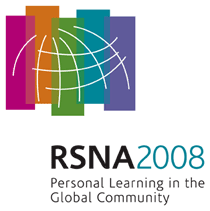
Abstract Archives of the RSNA, 2008
J. Bruce Kneeland MD, Presenter: Nothing to Disclose
Walter Robert Witschey BS, Abstract Co-Author: Nothing to Disclose
Jess Lonner MD, Abstract Co-Author: Nothing to Disclose
Matthew Sochor BS, Abstract Co-Author: Nothing to Disclose
Matthew Fenty BS, Abstract Co-Author: Nothing to Disclose
Ravinder Reddy PhD, Abstract Co-Author: Nothing to Disclose
Conventional T1 and T2 MRI are not consistently specific and sensitive for the detection of early articular cartilage lesions seen with OA. The objective of this study was to test the hypothesis that chondromalacia observed during arthroscopy correlates with changes observed in T1ρ MRI.
To accomplish the objectives, in a blinded, retrospective study, we investigated whether T1ρ MRI can reliably detect chondromalacia using arthroscopy as a gold standard. 9 normal subjects (2 men and 7 women) and 6 symptomatic patients (3 men and 3 women), validated at arthroscopy to have one or more regions of mild or moderate OA and between 30 and 59 years of age, were recruited to the study. Arthroscopy of the knee was performed with chondromalacia classification by Outerbridge. MRI was conducted 2-3 months post-arthroscopy on a 1.5 T Siemens Sonata with 40 mT/m gradients, body transmit and 8-channel knee extremity coil. The MRI protocol consisted of sag T1-w mpRAGE, three-plane T2-w FSE and two-plane 3D T1ρ-prepared bGRE sequence. T1ρ images were interpolated, automatically coregistered to T1-w images and semiautomatically segmented using LiveWire (3DViewnix; Matlab). Images were fit pixelwise to S(TSL)=S0exp(-TSL/T1ρ) to spatially map T1ρ. A single blinded radiologist performed classification by KL score.
T1ρ was not normally distributed among populations by a Lillilifors test (asymptomatic: p<0.03; symptomatic: p<0.02). Median T1ρ relaxation times among symptomatic and asymptomatic subjects were significantly different by a nonparametric Wilcoxon rank sum test (p<0.001). Symptomatic exceeded asymptomatic articular cartilage median T1ρ by 2.5 to 9.2 ms by a bootstrap confidence interval (CI) test (CI = 95%; N=1000). 4 grade 1 lesions and 3 grade 2 lesions were observed in 5 of 6 patients which in all cases corresponded with focal or diffuse increased T1ρ on MRI.
T1ρ was consistently correlated with lesions detected by arthroscopy in 6 patients with mild and moderate chondromalacia. T1ρ was significantly higher in patients than in healthy subjects.
T1ρ MRI consistently detected changes in cartilage that are only inconsistently detected by conventional MRI.
Kneeland, J,
Witschey, W,
Lonner, J,
Sochor, M,
Fenty, M,
Reddy, R,
Correlation between T1ρ MRI and Arthroscopy in Adults with Mild and Moderate Chondromalacia. Radiological Society of North America 2008 Scientific Assembly and Annual Meeting, February 18 - February 20, 2008 ,Chicago IL.
http://archive.rsna.org/2008/6014920.html

